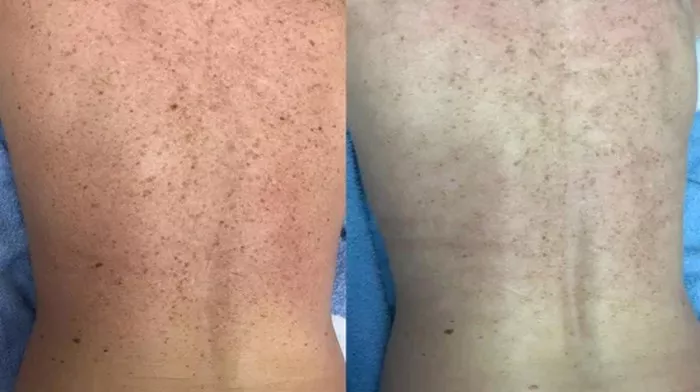Freckles are small, flat, brown spots on the skin that are caused by an increase in melanin production. While freckles are harmless, they can be unsightly and cause concern for some people. In this article, we will explore the best treatment for freckles, their causes, and how to prevent them from forming.
Causes of Freckles
Freckles are caused by an increase in the production of melanin, which is the pigment that gives skin its color. Melanin production is stimulated by exposure to sunlight, which is why freckles are more common in people with fair skin who are exposed to the sun for long periods of time.
Freckles can also be caused by genetics, with some people being more prone to developing freckles due to their family history. Hormonal changes, such as those that occur during pregnancy or puberty, can also increase the production of melanin and lead to the formation of freckles.
The Best Treatment for Freckles
While freckles are harmless and do not require treatment, some people may wish to reduce their appearance for cosmetic reasons. There are several treatment options available for freckles, including:
Topical Treatments: Topical treatments, such as hydroquinone, retinoids, and azelaic acid, can help reduce the appearance of freckles by inhibiting the production of melanin. These treatments are available over-the-counter or by prescription and should be used under the guidance of a dermatologist.
Chemical Peels: Chemical peels involve the application of a chemical solution to the skin, which causes the top layer of skin to peel off. This can help reduce the appearance of freckles by removing the top layer of skin, which contains the excess melanin. Chemical peels should only be performed by a qualified dermatologist.
Laser Therapy: Laser therapy involves the use of a laser to target the excess melanin in the skin, which causes it to break down and be absorbed by the body. This can help reduce the appearance of freckles. Laser therapy should only be performed by a qualified dermatologist.
Cryotherapy: Cryotherapy involves the use of liquid nitrogen to freeze the freckles, which causes them to peel off. This can help reduce the appearance of freckles. Cryotherapy should only be performed by a qualified dermatologist.
Preventing Freckles
While freckles cannot be completely prevented, there are several steps that you can take to reduce their formation:
Wear Sunscreen: Protect your skin from the sun’s harmful UV rays by wearing a broad-spectrum sunscreen with an SPF of 30 or higher. Reapply sunscreen every two hours or after swimming or sweating.
Wear Protective Clothing: Wear protective clothing, such as a hat and long-sleeved shirt, to protect your skin from the sun’s harmful UV rays.
Seek Shade: Seek shade during the sun’s peak hours, which are typically from 10 a.m. to 4 p.m.
Avoid Tanning Beds: Tanning beds can increase the risk of skin damage and the formation of freckles. Avoid tanning beds to reduce your risk.
Use Skin Lightening Products: Use skin lightening products, such as vitamin C serums and niacinamide, to help reduce the appearance of freckles and prevent their formation.
Conclusion
Freckles are a common skin condition that are caused by an increase in melanin production. While freckles are harmless, some people may wish to reduce their appearance for cosmetic reasons. The best treatment for freckles includes topical treatments, chemical peels, laser therapy, and cryotherapy. However, the best way to prevent freckles is to protect your skin from the sun’s harmful UV rays by wearing sunscreen, protective clothing, and seeking shade. If you are concerned about the appearance of your freckles, consult with a qualified dermatologist to determine the best treatment plan for your needs.
FAQs
1. Can you permanently remove freckles?
While it’s challenging to permanently eradicate freckles, various treatments can lighten or reduce their appearance. These include laser therapy, chemical peels, cryotherapy (freezing), microdermabrasion, and topical bleaching agents. However, freckles may gradually return with sun exposure or genetic predisposition.
2. What is the most effective treatment for freckle removal?
The effectiveness of freckle removal treatments depends on factors such as skin type, freckle size, and individual response. Laser therapy, particularly intense pulsed light (IPL) and fractional laser treatments, is often considered one of the most effective methods for reducing freckles. These lasers target melanin pigments in the skin, breaking them down to diminish freckles gradually.
3. What is the best thing to use for freckles?
Topical treatments containing ingredients like hydroquinone, retinoids, kojic acid, vitamin C, and alpha hydroxy acids (AHAs) can help lighten freckles over time. Additionally, broad-spectrum sunscreen with SPF 30 or higher is essential to prevent further darkening of freckles caused by sun exposure.
4. What is the new treatment for freckles?
Emerging treatments for freckle removal include advanced laser technologies, such as picosecond lasers, which deliver ultra-short pulses of energy to target pigment with minimal heat damage to surrounding skin. Additionally, dermatologists may explore combination therapies or novel topical formulations to enhance freckle treatment outcomes. However, it’s essential to consult a qualified dermatologist or skincare professional to determine the most suitable and effective treatment for your specific needs.


